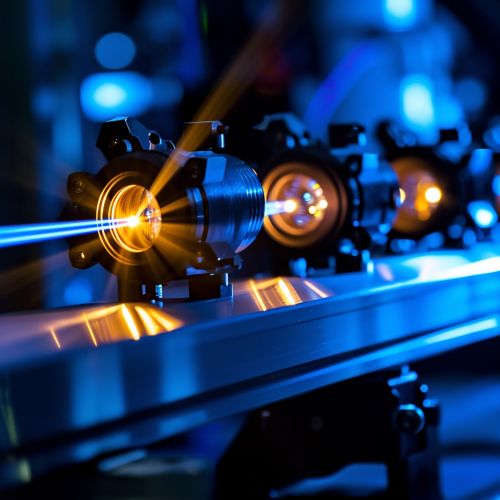Mode-locking
Introduction
Mode-locking is a technique in optics where a laser can be made to produce pulses of light of extremely short duration, on the order of picoseconds (10^-12 seconds) or femtoseconds (10^-15 seconds). This is achieved by creating a standing wave in the laser's resonant cavity, which effectively "locks" the different frequency modes of the laser together, causing them to all phase up and down in unison. This results in a laser beam that is composed of a series of light pulses rather than a continuous wave.


Principle of Operation
The principle of operation of a mode-locked laser involves the interference of different frequency modes within the laser's resonant cavity. In a typical laser, the light waves produced by the laser medium can have any of a range of frequencies, each of which corresponds to a different "mode" of the laser. When these modes are all oscillating independently, the result is a continuous wave laser beam. However, if the phases of these modes can be synchronized, or "locked" together, they will interfere constructively at regular intervals, producing a series of light pulses.
This mode-locking is achieved by placing an element within the laser's resonant cavity that modulates the loss of the cavity at a frequency equal to the round-trip frequency of the light waves. This element, known as a mode-locker, can take several forms, including a saturable absorber, an acousto-optic modulator, or an electro-optic modulator. The mode-locker effectively "gates" the light waves, allowing them to pass through only when they are in phase.
Types of Mode-Locking
There are several different types of mode-locking, each of which uses a different mechanism to achieve the synchronization of the laser's modes.
Active Mode-Locking
In active mode-locking, an external modulator is used to modulate the loss of the laser's resonant cavity at a frequency equal to the round-trip frequency of the light waves. This can be achieved using an acousto-optic or electro-optic modulator. The modulator is driven by an external signal generator, which allows precise control over the timing and duration of the light pulses.
Passive Mode-Locking
Passive mode-locking involves the use of a saturable absorber within the laser's resonant cavity. A saturable absorber is a material that absorbs light at high intensities but allows it to pass through at low intensities. This creates a self-amplifying effect, where the light pulses become more intense as they pass through the absorber, leading to a rapid increase in the intensity of the light pulses.
Hybrid Mode-Locking
Hybrid mode-locking is a combination of active and passive mode-locking. In this technique, an active mode-locker is used to initiate the mode-locking process, after which a passive mode-locker maintains the synchronization of the modes. This allows for the precise control of active mode-locking, combined with the self-amplifying effect of passive mode-locking.
Applications
Mode-locked lasers have a wide range of applications in various fields, including spectroscopy, microscopy, and telecommunications. In spectroscopy, the short pulses of light produced by a mode-locked laser can be used to probe the properties of materials on very short timescales. In microscopy, mode-locked lasers are used in techniques such as two-photon excitation microscopy, where the short pulses of light can be used to excite fluorescent dyes within a sample. In telecommunications, mode-locked lasers can be used to generate high-speed optical signals for data transmission.
